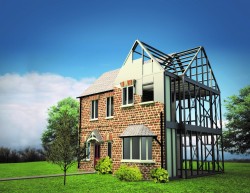The construction industry is in the process of change, with an increasing number of developers and contractors favouring off-site and modular construction over the more traditional building methods. Here, Chris Holleron - Group Product Manager, Housing at Hadley explores off-site construction within the housing sector and the role that light-gauge steel frames can play.
Off-site and modular construction has long been viewed as a crucial part of construction's future, with increased calls for the sector to progress and develop its approach. One of the most recent of which would be the Farmer Review: 'Modernise or Die', in which Mark Farmer recommended Government promote the use of pre-manufactured solutions for the housing sector.
Off-site construction carries with it many benefits. It can save valuable time on site, with large portions of the structure pre-assembled and less likelihood of delays caused by poor weather conditions. In fact, projects that implement off-site construction can be completed between 30% and 50% faster than traditional methods. What's more, less skilled labour is required on site - an important factor considering the ongoing skills shortage - and also less space, a particular concern for high-rise or city development projects where site access or space can be restricted.
While off-site construction may be particularly well-suited to high-rise or commercial applications, and project teams are increasingly delivering in this way, it seems that the housing sector is also starting to reap the rewards, with a large number of leading housebuilders committing to off-site construction. For example, L&Q has said that by 2025 all of its new homes will be built using modern methods of construction and Berkeley Homes has pledged to build 1,000 homes per year at its new off-site factory.
The advantages of these modern methods of construction, such as off-site and modular, are numerous, especially in the current climate where high-quality, affordable housing is desperately required in the UK. It is estimated that, in order to satisfy the current and future housing demand, the country needs to build 340,000 homes every year until 2031 - a significantly higher figure than the Government's annual target of 300,000 homes. Given the targets the UK faces, it is clear that off-site construction should play a fundamental role in the future of the housing sector. However, a successful project relies on so many factors - including its individual building components.
Light-gauge steel frames are a fundamental aspect of off-site construction, capable of being used for a wide-range of building types, including housing and low-rise applications. The steel building envelope components can be fabricated to specific project requirements and pre-assembled in a controlled factory environment, before being delivered to site as and when they are required.
Hadley Steel Framing is one such manufacturer that offers a fabrication service, with its dedicated project design team also able to provide technical support. Hadley supplies structural external and internal wall panels, constructed from lightweight cold-rolled steel sections for high strength and low weight. These panels are assembled and bolted together off-site, before being delivered to site, lifted and fixed in place.
What's more, as a result of its lightweight structure, Hadley's light-gauge steel frames provide housebuilders with an easier to erect alternative to steel or concrete primary frames. In addition, they can provide relative savings on foundation loads and sizes, as the overall building weight would be reduced.
With the demand for new housing in the UK at an all-time high, it perhaps comes as no surprise that there has been a visible increase in off-site construction within the housing sector. These methods can provide housebuilders with the means of producing the high-quality homes that the country needs and at a far faster rate than the more traditional building methods. Using building materials, such as light-gauge steel frames, can further improve the speed and efficiency of the build rate, and developers should ensure that they liaise with reputable manufacturers who can provide pre-fabrication support and advice.
For more information please visit: www.hadleysteelframing.com or www.hadleygroup.com









